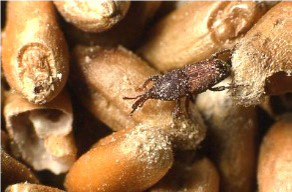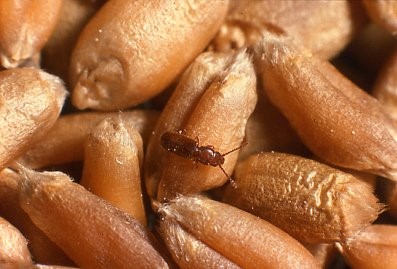Did the Extreme Cold Temperatures Kill Stored Grain Insects?
During the middle of February 2021, Oklahoma experienced some brutally cold temperatures. Were those temperatures low enough for a long enough period to kill insect pests in stored grain? Unfortunately, the answer is no.
Large quantities of mainly hard red winter wheat are stored in steel bins, concrete silos, and flat storages across Oklahoma. Some of these storage units hold 250,000 bushels of grain or more and can be over 75 feet in diameter. Grain is a poor conductor of heat and when the surrounding temperature lowers, heat from a mass of grain is slowly lost to the surrounding air. Grain has an insulation value of about R=1 per inch, so large masses of grain are well insulated, and those cold temperatures never reach the center of the grain mass. Also, stored grain insects will tend to migrate to warmer regions in a grain mass and avoid colder areas. Therefore, insect pests that infest stored grain have an advantage over insects that infest plants in the field.
There are three temperature zones for any organism: optimum, where the fitness of the species is greatest for rate of development and number of offspring produced; suboptimum, where temperatures are above or below the optimum zone and where species can still complete their life cycle but at a slower rate; and lethal, where temperatures are above or below the suboptimum zone and kill the organism over time. Table 1 describes these temperature zones for stored product insects (Fields 1992). However, the species of insect, stage of development, and moisture content of the commodity will influence the response to temperature.
| Zone | Temp Range (°F) | Effect |
|---|---|---|
| Lethal | above 144 | death in < 1 minute |
| 122 to 144 | death in < 1 hour | |
| 113 to 122 | death in < 1 day | |
| 95 to 108 | populations die out, mobile insects seek cooler environments | |
| Suboptimal | 95 | maximum temperature for reproduction |
| 91 to 95 | slower population increase | |
| Optimal | 77 to 90 | maximum rate of population increase |
| Suboptimal | 55 to 75 | slower population increase |
| Lethal | 41 to 55 | slowly lethal |
| 37 to 41 | movement ceases | |
| 14 to 32 | death in weeks, or months if acclimated | |
| -13 to 5 | death in < 1 hour |
Adapted from P.G. Fields, 1992
Here are a couple of examples to emphasize the hardiness of stored grain insects and to demonstrate the difference between temperature effects on various species insects.
Insect survival after exposure to 32° F for 7 days was examined in laboratory bioassays for control of adults of six major stored product beetle species: sawtoothed grain beetle, rusty grain beetle, hide beetle, rice weevil, red flour beetle, and confused flour beetle. Insect survival for all species except the rice weevil (Fig. 1) was not affected by the exposure to 32° F, regardless of the acclimation scenario (Athanassiou and Arthur, 2020). In contrast, exposure to 32° F drastically reduced survival of rice weevils. Results of this experiment demonstrated that acclimation played a limited role in adult survival of five of the six tested species, and that exposure of adults to 32 °F for 7 days had no effect in survival of these species.

Figure 1. Rice Weevil
In another study in Winnipeg, Canada, the rusty grain beetle (Fig. 2) survived the winter even though the outside temperatures rarely rose above freezing. In this study, endemic populations of this species survived two winters in a metal storage bin that contained 1000 bushels of wheat when the minimum outside temperatures for the two coldest months ranged from -4 to -22° F (Smith, 1970). With acclimation, his insect can also supercool itself. Supercooling is the process of cooling a liquid or a gas below its freezing point without it becoming a solid. Rusty grain beetle adults were able to lower their supercooling point from 2.3° F for non-acclimated adults to -4° F for adults acclimated at 59° F. Therefore, the rusty grain beetle can survive the winter in stored grain facilities because of its ability to acclimate to low temperatures.

Figure 2. Rusty grain beetle
Since the cold weather did not kill many, if any, insects in stored grain facilities in Oklahoma during the middle of February, it is imperative that you continue to monitor for insect populations within your facilities to determine whether action needs to be taken to minimize potential damage to the grain.
References:
Athanassiou, C.G. and F.H. Arthur. 2020. Cool down – warm up: differential responses of stored product insects after gradual temperature changes. Insects, 11, 158, www.mdpi.com/journal/insects.
Fields, P.G. 1992. The control of stored-product insects and mites with extreme temperatures. Journal of Stored Product Research, 28: 89-118.
Smith, L.B. 1970. Effects of cold-acclimation on supercooling and survival of the rusty grain beetle, Cryptolestes ferrugineus (Stephens) (Coleoptera: Cucujidae), at subzero temperatures. Canadian Journal of Zoology, 48: 853-858.
